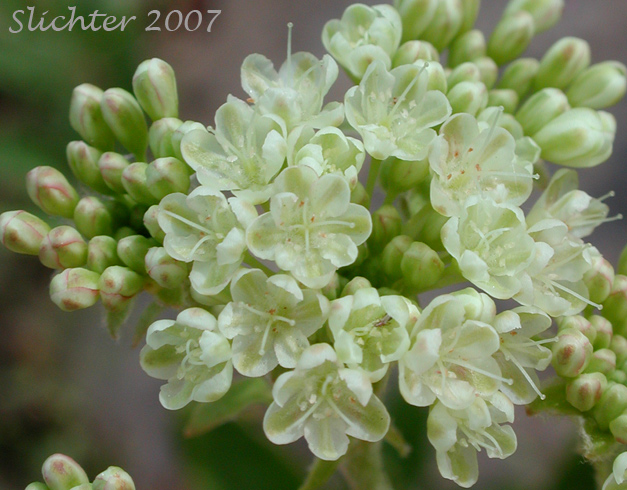
 The
photo at right shows the inflorescence of Wyeth buckwheat. Note the involucre
with the long oblong lobes subtending the cluster of whitish flowers. Photographedalong the Umatilla Rim Trail #3080 near Tollgate in the Umatilla N.F.............June 24, 2007.
The
photo at right shows the inflorescence of Wyeth buckwheat. Note the involucre
with the long oblong lobes subtending the cluster of whitish flowers. Photographedalong the Umatilla Rim Trail #3080 near Tollgate in the Umatilla N.F.............June 24, 2007.
Also known as creamy buckwheat, Wyeth buckwheat is an upright buckwheat to 10-40 cm tall, with numerous leaves both at the base and on the stems. Several varieties of this species have a whorl of large cauline leaves midway up the stem with a smaller whorl of leaves directly below where the inflorescence branches into an open umbel. The leaves and stems are covered with dense hairs, although the upper blade surface maybe somewhat greenish. The leaf blades are linear to oblanceolate in shape with rounded to acute tips, the base of the blade narrowing gradually to the petiole. The leaves range from 3-8 cm long.
The inflorescence is an umbel that is subtended by a whorl of leaf-like bracts. The primary rays are either simple or umbellately branched again. The woolly involucres are bell-shaped with linear to lanceolate lobes from 2-3 mm long. The involucral lobes may be spreading or reflexed. The glabrous perianth is creamy or white or occasionally tinged with yellow or rose.
Wyeth buckwheat is grazed by deer, elk and domestic sheep. Small rodents use the seeds as food.
variety angustifolium: Flowering stems with bracts at about midstem. Leaves narrow, usually less than 6 mm wide. Found east of the Cascade Mts. from British Columbia south to northeastern California and east to western Montana, Wyoming, Utah and Nevada. Infrequently found within the range of variety heracleoides.
variety heracleoides: Flowering stems with bracts at about midstem. Leaves 8-15 mm wide. Found in southeastern Washington, northeastern Oregon, and west-central Idaho.
variety leucophaeum (formerly var. minus): Flowering stems without bracts below the inflorescence. Found in Chelan, Kittitas and Douglas Counties and eastward to Spokane County in Washington.
Wyeth buckwheat is found from the lowlands to 6000 ft ridges, found in both Ponderosa Pine forests and sagebrush, and sandy or gravelly open areas.
Wyeth buckwheat is a widespread species, from southern British Columbia south along the east side of the Cascades to northeast California and eastward to the Rocky Mts.
In the Columbia River Gorge, Wyeth buckwheat is found east on both sides of the river to the east of US Highway 97, and generally is more common on natural slopes that are out of the gorge canyon itself.
Wyeth buckwheat should make a nice wildflower for the natural garden east of the Cascades.